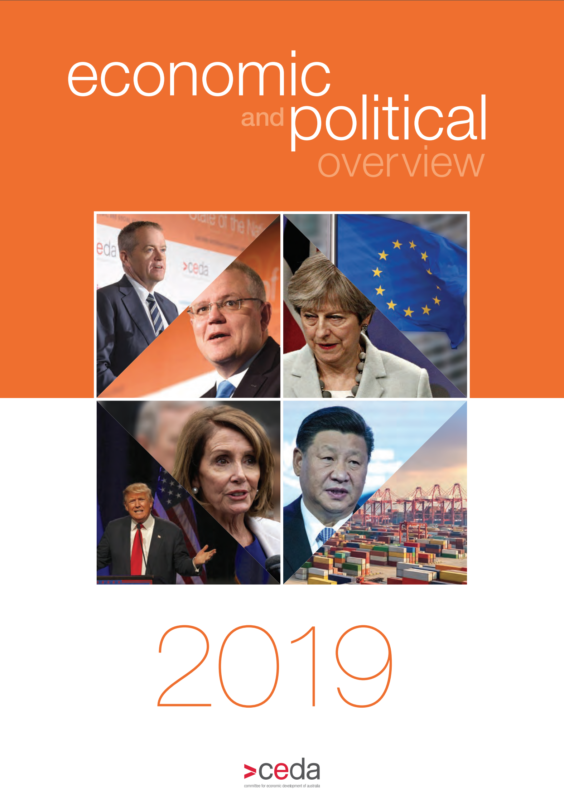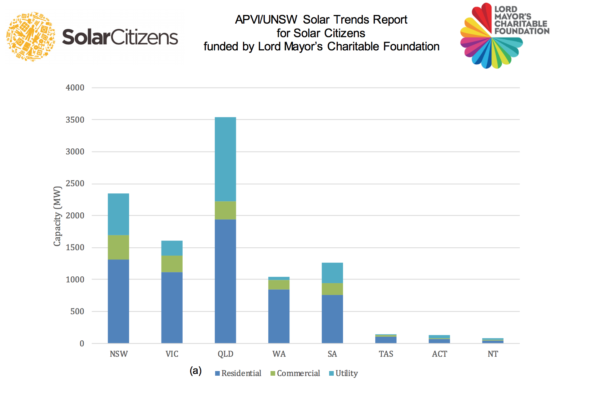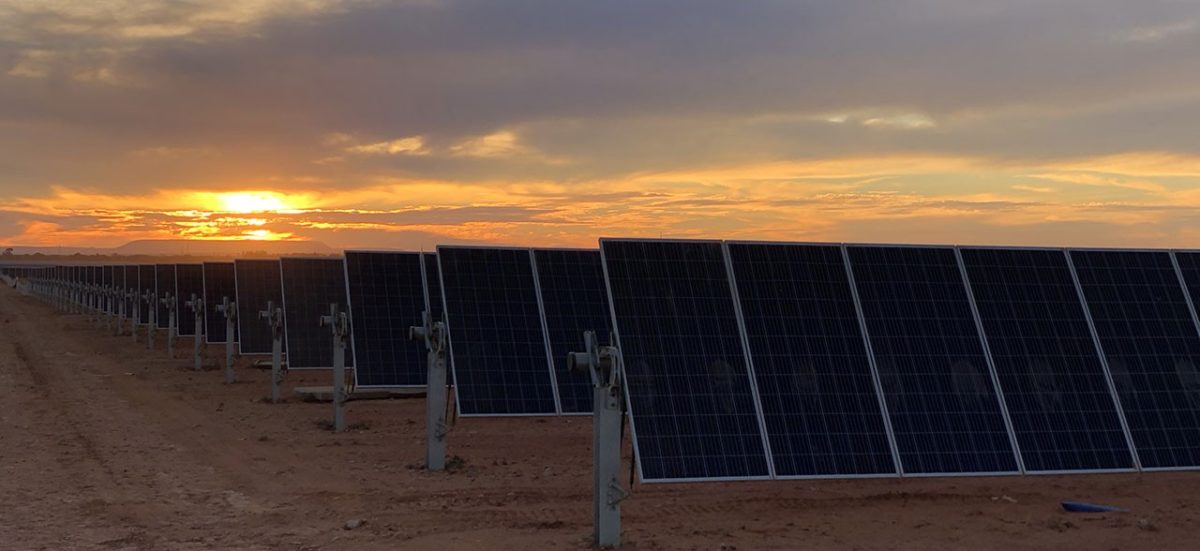The sun will shine and the wind will blow, to twist a phrase. Clean, cheap energy has become a certainty, and while Australia’s state governments are working on mechanisms to effectively bring about Australia’s transition to renewable energy sources, the Federal Government refuses to manage the necessary transition away from fossil fuels.
The 2019 Economic and Political Overview (EPO), launched in Brisbane today by CEDA, an independent, not-for-profit organisation made up of members as diverse as Shell Australia, the Australian Rail Track Corporation, PwC Australia and the CSIRO, has emphasised the growing global and national uncertainties affecting Australia’s economy, and argued for strong, reliable policies in sectors within the government’s control.
“Arguably in almost 40 years of producing the CEDA EPO report, there has never been a year with so many question marks about how the year will unfold,” said CEDA CEO Melinda Cilento, referring to US-China relations, questions around the strength of the Chinese economy, and the disruption of a Federal Election at home.

CEDA
“In an election year, there is an acute risk that policy discipline will slip,” she says, adding that that is, “something Australia can ill afford”, given the need to build economic buffers against outcomes beyond Australia’s influence.
Energy leads CEDA’s proposed areas in which focus and clear policy have been lacking.
And although the Government line has been to constantly reiterate the need to bring energy prices down for consumers, it seems misguided at best in its interpretation of how to create “policy that delivers for the community” in this regard, an imperative identified by CEDA’s nationwide “community pulse poll”.
Consider how state-based focus on enabling access to renewable energy on both a large scale and a residential scale are reducing consumer energy bills, have reduced Australia’s carbon emissions from electricity production and are creating new jobs in a sustainable industry. A few examples:
Victoria’s outlook to a bright horizon
In late 2018 the Andrews Labor Government was reelected in part on its promise to commit to a renewable energy target (RET) of 50% by 2030. This built on its June 2016 promises to power the state with 25% renewable energy by 2020 and 40% by 2025.
Victoria has underpinned its RET with legislation and policy reforms that provide a foundation from which it can “manage climate change risks”, and “maximise the opportunities that arise from decisive action”, its policy states. Victoria’s RET has been supported by a Climate Change Act, a New Energy Jobs Fund and a Government Renewable Energy Purchasing initiative, which together have provided large-scale investors with confidence in the government’s direction and commitment.
The state’s $1.24 billion Solar Homes program, which opened for applications in September 2018, provides rebates of $2,225 to support the installation of solar panels on 24,000 homes, as well as up to $1,000 for solar hot water systems on 6,000 homes, under the current initiative set to expire on June 30.
Overall, Victoria aims to put solar panels on 700,000 Victorian homes, including 50,000 rental homes, and support a further 60,000 homes to install solar hot water and 10,000 homes to install solar batteries.
The scope of the program is such that it is encouraging businesses to hire employees to meet ongoing demand. In late 2018, Green Energy Markets figures showed that the boom in large-scale renewable projects had already generated 6000 jobs in Victoria.
Victoria’s Solar Homes program will also continue to reduce pressure on the electricity grid, as homes become more self-sufficient in their energy production and consumption.
Living up to the Sunshine-State moniker
The Queensland Government, too, is “committed to a planned and measured approach to achieving a target of 50% renewable energy by 2030”, according to its “Powering Queensland” report on the state’s renewable achievements.
Research by an expert panel, which informed Queensland policy development “found that the target could drive $6.7 billion of new investment, and deliver a net increase in employment of 6400 – 6700 full-time equivalent positions on average per year between 2020 and 2030.”
In late 2018, Australian Photovoltaic Institute (APVI) data showed Queensland having the highest installed capacity of solar-energy generation of any Australian state, and the highest residential rooftop penetration, with half a million or more than 32% of homes under solar panels.
The Queensland Government’s latest renewable-supporting initiative, as it accelerates toward its stated target of 3GW of rooftop solar by 2020, is a grants and loans scheme designed to help up to 1500 Queensland households and small businesses cut their power bills by storing solar power for use after sunset.
“Just as we have one of the highest penetrations of rooftop solar in the world, we are aspiring to be a world leader in battery storage,” said Queensland’s Energy Minister, Anthony Lynham.
Sunny ridge in the great divided range
In New South Wales, which is itself amping up to a March 23 state election, public pressure is intense for the incumbent Liberal Party to distance itself from Federal fossil-fuel nurturing.
In a largely policy-free environment, NSW has seen citizens adopt rooftop solar with a wattage and a will second only to Queensland; and the state’s utility-scale solar penetration has also substantially increased, according to last year’s APVI/UNSW Solar Trends report for Solar Citizens.

Solar Citizens
In the past two weeks, each major party in NSW — incumbent Liberals, Labor challengers and the Greens — has focused on solar policies as a cornerstone of its commitment to energy transition.
It’s worth noting that the Solar Citizens Solar Trends report calculated that, at the end of 2018, Australian homes and businesses that had so far invested in solar are reducing Australia’s electricity-sector emissions by 4% (or 7.4Mt).
Jenny Gordon, Chief Economist at Nous Group, who compiled the ‘Domestic Policy Overview’ in today’s CEDA report, writes that while Australia’s investment in renewable energy — both already installed and coming down the pipeline — will enable at least its electricity sector meet the 26% Paris emissions reduction target, “this sector needs to do more of the heavy lifting as it is more expensive for other sectors to reduce emissions” to meet 26% reductions in emissions overall by 2030.
This content is protected by copyright and may not be reused. If you want to cooperate with us and would like to reuse some of our content, please contact: editors@pv-magazine.com.









By submitting this form you agree to pv magazine using your data for the purposes of publishing your comment.
Your personal data will only be disclosed or otherwise transmitted to third parties for the purposes of spam filtering or if this is necessary for technical maintenance of the website. Any other transfer to third parties will not take place unless this is justified on the basis of applicable data protection regulations or if pv magazine is legally obliged to do so.
You may revoke this consent at any time with effect for the future, in which case your personal data will be deleted immediately. Otherwise, your data will be deleted if pv magazine has processed your request or the purpose of data storage is fulfilled.
Further information on data privacy can be found in our Data Protection Policy.